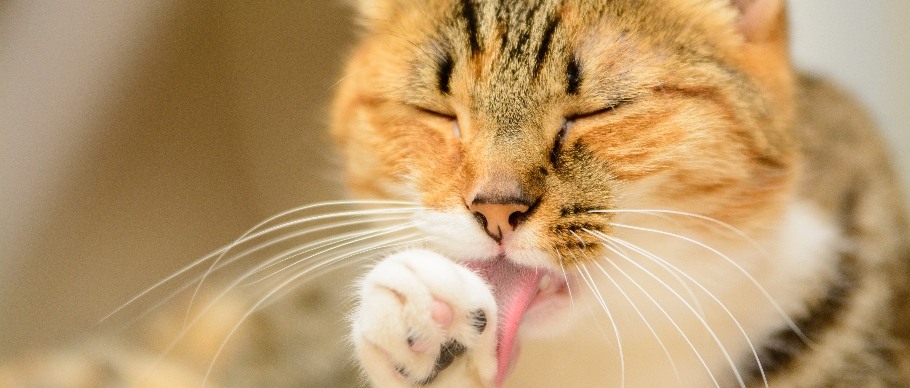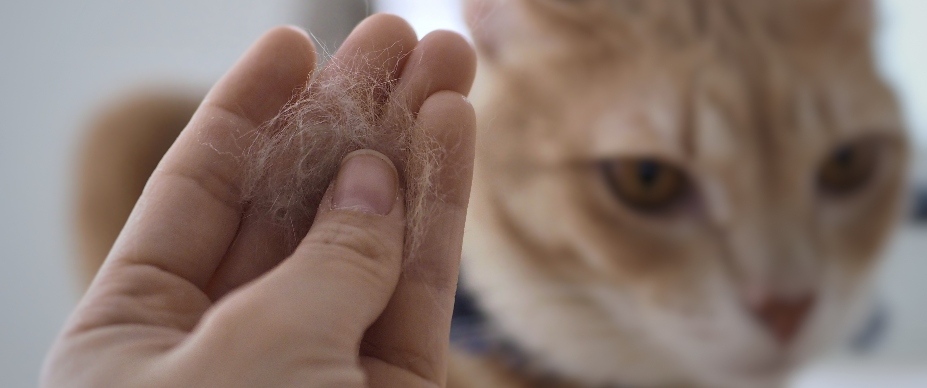Help! Why Is My Cat Shedding So Much?
We call our pets “furry friends” for a reason! Shedding is nature’s way of helping cats maintain a healthy coat. This process expels dead hair, allowing new hair to emerge from the follicles. While it’s completely normal to see bits of fur around your home, finding it scattered just about everywhere may have you wondering: why is my cat shedding so much?
Causes of Excess Shedding

Heavy shedding is easy to notice, but finding out why your cat is shedding so much may not always be so obvious. From their diet to changes in their surroundings, here are some possible reasons for excess shedding.
Allergies: Seasonal, skin, and food allergies can leave cats feeling itchy. All that scratching can rip out hair, leaving bald patches on their body. If you suspect your cat has allergies, your veterinarian can provide solutions, which may include medication.
Parasites: Similarly, cats who are infected with parasites are often tempted to scratch and may lose some hair. Frequently check your cat for ticks, fleas, lice, and mites. It’s also wise to practice flea prevention. Household chores like mowing your lawn or vacuuming areas where your cat likes to hang out can make a big difference!
Stress: While cats spend up to half their time awake grooming themselves, they may lick their coat even more than usual to cope with stressful situations. This habit—known as compulsive grooming—usually develops from changes in a cat’s surroundings or schedule, such as moving to a new home or spending more time alone. If you have multiple kitties, you may even see your cats grooming each other to help manage stress.
Low-quality food: Did you know the nutrients your cat consumes can impact their coat’s overall health? Felines who don’t get enough fat or protein in their diet are more likely to develop hair that’s brittle and dry. Feeding your cat wholesome food with plenty of omega-3 fatty acids will help their coat look and feel great!
Fungal infections: Often picked up from the environment or other animals, fungal infections can lead to hair loss. Ringworm is one of the most common infections, leaving a scaly ring and missing hair on cats’ skin. Luckily, your vet or groomer can recommend topical treatments that are specially formulated to soothe irritated skin.
Disease: Certain diseases can cause hair loss. If your cat is also experiencing weight loss, vomiting, or frequent urination, they may need veterinary attention.
→ RELATED: 9 Cats That Don’t Shed (…Much)
How to Keep Cat Shedding Under Control

Good news, cat parents: loose fur doesn’t have to take over your floors, clothes, and furniture! A little bit of care can prevent your cat from shedding a lot and keep them feeling their best.
Brush your cat’s coat regularly: A quick daily brushing can go a long, long way! Use a cat slicker brush to remove excess hair before it accumulates around your home. Slicker brushes also stimulate the skin’s natural oils, promoting a healthy and lustrous coat. For a more therapeutic experience, you can use a grooming mitt to gently massage your cat’s coat and remove loose hair.
Give them a bath: Although cats are dedicated self-groomers, they still need occasional bathing to stay clean. Give your cat a bath every few weeks to wash away dead hair, dirt, and other debris. If your kitty gets antsy when you put them in the tub, make sure you stay calm and collected to promote positive behavior. Have some treats on hand to reward your cat for keeping their cool!
Offer hairball supplements: Heavy shedding can cause your cat to cough up more hairballs than usual, which can be uncomfortable for them and adds extra cleanup for you. Hairball supplements may help prevent hairball formation, limiting this not-so-pleasant side effect of cat shedding. Keeping your cat busy, feeding a balanced diet, and grooming their coat can also help.
Schedule vet checkups: Your vet can identify potential medical issues before they result in hair loss or more serious problems. Healthy adult cats should see the vet at least once a year, while kittens, seniors, and cats with chronic medical conditions will need more frequent checkups. Your vet’s office can provide a recommended checkup schedule based on your feline’s specific needs.
How Much Cat Shedding Is Normal?
How much your cat should shed depends on a couple of key factors. Outdoor cats shed a lot in the spring and fall as they transition toward or away from a thick winter coat. Indoor cats are more likely to shed lightly all year long, owing to their home’s artificial lighting and controlled temperature that alter the natural shedding process.
Your cat’s breed also plays a role. Long-haired breedssuch as Persians, Ragdolls, and Maine Coons often shed more heavily than short-haired breeds like Bombays, Bengals, and Devon Rexes. The Sphynx and other hairless kitties shed the least, making them a great choice for pet parents with allergies.
Be Smart About Shedding
You can learn a lot about your kitty just by observing them! Take note of their shedding and self-grooming habits, and keep your eyes peeled for anything out of the ordinary. And of course, caring for your kitty’s coat and giving them nutritious meals will help keep shedding in check while promoting a healthy lifestyle.
Shedding isn’t the only bodily function that often raises questions. Find out why your cat may be sneezing so much and what it could indicate.








